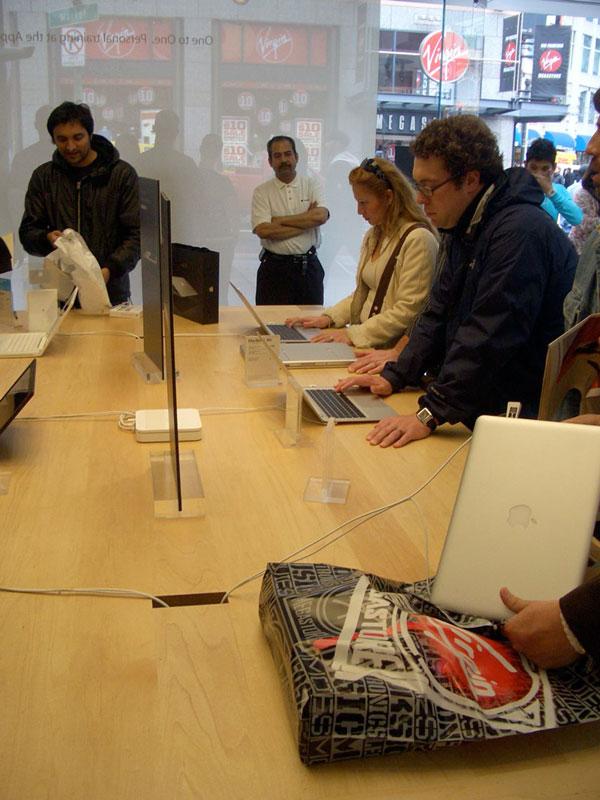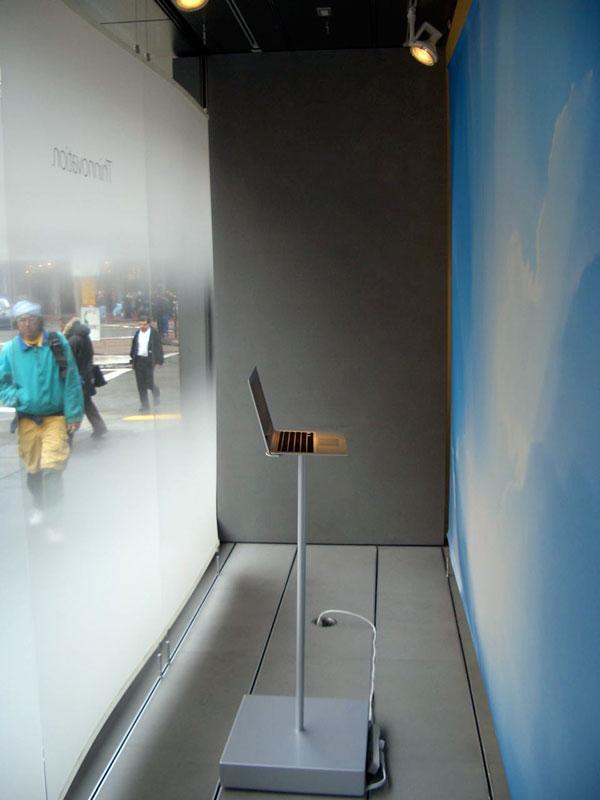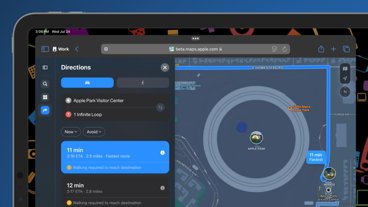What's wrong with the MacBook Air?
Everyone Can Critique
"In many ways, the work of a critic is easy. We risk very little, yet enjoy a position of over those who offer up their work to ourselves and our judgement. We thrive on negative criticism, which is fun to write and to read. But the bitter truth we critics must face is that in the grand scheme of things, the average piece of junk is probably more meaningful than our criticism designating it so. But there are times when a critic actually risks something, and that is in the discovery and defense of the new. The world is often unkind to new talent, new creations. The new needs friends."
Those words of Anton Ego, voiced by Peter O'Toole in Pixar's Ratatouille, well describe the task in reviewing the new MacBook Air. Perhaps it's no coincidence that Steve Jobs had a hand in producing both the movie and the new laptop. While the heavy lifting was done by writers at Pixar and engineers at Apple, both push their audience and the industry to think differently.
Just prior to unveiling the MacBook Pro onstage at Macworld Expo, Jobs coyly highlighted Ratatouille as one of his favorite movies. That's because the rat in Ratatouille secretly was Jobs: the unlikely source of something new who has been delighting patrons and investors alike despite his real identity as an opinionated, reality distorting visionary who talks about his business in terms of art and design and craftsmanship that challenges the market's status quo rather than simply being another straight-laced bean counter promising to deliver more of the same old thing wrapped up in vapor and grandiose buzzwords.
As Ego's monologue noted, it would be easy and fun to negatively critique the new MacBook Air only as missing features of the MacBook Pro; however, the new model isn't just a rebadged Pro with a smaller 13.3" display, some shaved off specifications, and a $200 price cut. It's something entirely new, and asks to be evaluated at such. How well does it achieve what it sets out to deliver? You can help us determine that by sending in your suggestions for critically putting the new Air through its paces.
Avoiding the Plague of Featuritus Vulgaris
My dad taught me that when going out to buy something, I should first make a list of features I actually want, and then only buy those features. That way, I wouldn't be suckered into paying extra for impractical options that sound valuable in the marketing pitch but aren't anything I'd really ever use or need. My overall success in buying things has seemed directly proportional to how well I heeded his advice.
For most people buying a laptop, the essential feature list involves snappy performance, great mobility, and a thoughtful, practical design. However, when you look at the laptops currently on sale, many are layered with other rather impractical features that suddenly sound indispensable once you're aware they exist. A recent must-have addition on many new PC laptops is the fingerprint reader unit used to log in, as well as the assortment of lots of external buttons and switches to manually turn off wireless or to launch applications. These might be used on rare occasions, but their primary function seems to be to add clutter.
Look past the junk features, and many laptops miss the true target. Many lack enough RAM to be useful, supply limited video output features, go without Bluetooth in their base models, and otherwise skimp where they should shine. The MacBook Air is so completely stripped of junk featuritus that many critics are worried it won't appeal to mainstream users, just as they feared the iPod wouldn't appeal to broad audiences because it couldn't play FM radio, or as they feared the iPhone wouldn't be popular because it didn't have a physical slide out keypad.
Instead, all three Apple products aimed at delivering a strong and appealing design to the point where their specification numbers faded into the background. Apple markets its products, not as a list of GHz and GB numbers, but the same way top automakers do: as well built and attractively crafted machines that have enough under the hood so that they just work. Most car buyers are swayed by sexy designs they find appealing or the utilitarian practicality they need rather than the foot pounds of torque the vehicle's engine provides at a given RPM range.
The Air Feature Gap
One thing that pundits of all stripes have been conspicuously silent about when talking about the MacBook Air is its backlit keyboard, which makes it far more appealing to use in dimly lit conditions such as inside an airplane fuselage. It's almost as if Apple made a list of practical features that consumers actually use, and based its engineering decisions upon that, rather than simply assembling the specifications everyone else was shipping in a similarly identical form factor.
As a mobile laptop user, I've always bought an extra battery for every PowerBooks and MacBook Pro I've owned. I even had the weighty option to use two batteries at once in my late 90s PowerBook G3, which could swap out its optical drive for a second battery. The thing is, I've almost never actually used any of those spares. For example, I carried around an extra battery at Macworld, but never had the opportunity or need to swap it despite the scarcity of power outlets on the show floor. Despite that, I probably wouldn't buy a new MacBook Pro that didn't have a replaceable battery.
However, the Air's light weight and slim profile offers significantly more portability than any other laptop Apple has ever offered, a factor that balances out its inability to trade out its battery pack for a spare. Given the new restrictions upon carrying extra batteries on airplanes, Apple's sealed battery decision makes sense for a light mobile laptop. That's not to say that some users will find the MacBook Pro a better fit, particularly if they have needs that require long term, battery-only operation.
The iPod and iPhone were reviled for having a sealed battery, but neither really presents a serious problem for users. The competitive market solved any fears that millions of iPods would be thrown away prematurely because of the relatively high cost of Apple's replacement service. It's easy to find do-it-yourself, higher capacity iPod battery kits for less than $10. The iPod and iPhone also have external battery accessories that allow them to use rechargeable AA or Lithium Polymer battery packs for extended use. If the Air presents any battery issues for users, expect third parties to provide solutions.
Similarly, I've also always paid a premium to have a SuperDrive in every laptop I've bought, despite the fact that in retrospect, I've actually burned less than a dozen DVDs in as many years of being primarily a mobile user. The simple fact is that many of features we think we desperately need in a laptop are not the same as what we'll actually use. That's also a key reason why Apple's product launches generate a hailstorm of pundit angst prior to selling well in the market.
And all those missing ports? Recall that the original iBook launched in 1999 also lacked FireWire, audio input, had a single USB port, and even offered no video output. It was also priced within $200 of the MacBook Air, yet sold well to the consumer market despite its flamboyant use of color and its risk-taking "toilet seat" design. The iBook SE that shipped the following year cost the same price as today's MacBook Air and still didn't offer VGA output or more than one USB port.
When critics say the MacBook Air won't sell in volume, it must be because they haven't witnessed the fawning interest displayed by users upon seeing it in person. In order to maximize that interest, Apple designed a new retail store window display that puts the MacBook Air on a revolving platform in front of a matte background of clouds and behind a gradient plexiglass sheet with the caption "thinovation."
It installed the new installations in place of the former giant iPhone display. The company appears to be unfazed by reports suggesting that it will have a hard time selling enough iPhones this year, and seems confident in its ability to bring ultra mobile laptops into the mainstream in 2008 just as it successfully pushed its high-end, sophisticated smartphone into the mass market last year.
What's on Your Feature List?
As we take the new MacBook Air to task and put it through its paces, we'll look at how well it does in the core requirements of performance, mobility, and design. We'll also evaluate how well its new software features, described in MacBook Air spawns new software solutions for missing hardware, serve as alternatives to built in optical and FireWire hardware.
What would you like to know about the Air? Post your comments or questions and we'll kick its tires for you that much harder in our upcoming in-depth review of the MacBook Air.
 Prince McLean
Prince McLean















 Amber Neely
Amber Neely
 Thomas Sibilly
Thomas Sibilly
 AppleInsider Staff
AppleInsider Staff
 William Gallagher
William Gallagher
 Malcolm Owen
Malcolm Owen
 Christine McKee
Christine McKee









236 Comments
What would you like to know about the Air? Post your comments or questions and we'll kick its tires for you that much harder in our upcoming in-depth review of the MacBook Air.
[ View this article at AppleInsider.com ]
Being a Macbook Pro owner I am interested in the Macbook Air as an ultralight mobile platform. I was looking for the Macbook Air to actually be the Macbook tablet but it did not appear. On the flip side The Macbook Air looks to be a close alternative. There are times when I do not want to go to the hassle of using the MBP due to it being a 17". Boot up times are better since 10.5 and that does not seem as big an issue for me as simply having to get some space to set it down. The Macbook Air looks like one could cradle it in their arm or hand and use the other for typing and mouse movements. I think a touch screen with the same funactionality as the iPhone and iPod touce would have been a nice added option but maybe in time it will appear...
"Given the new restrictions upon carrying extra batteries on airplanes,..." is an irrelevant comment.
The new restrictions do NOT affect people who want to carry an extra laptop battery.
A comparison chart of the application speeds between MB, MBA and MBP would be nice.
Perhaps my brain is a bit slow today, but I am missing the point of this story.
Is it based on the premise that AI readers/posters have not yet had the opportunity or interest to weigh in on "what they would like to know about the Air?"
1) Is the screen really glass?
2) How much do the separate components weigh? Specifically the battery and case.